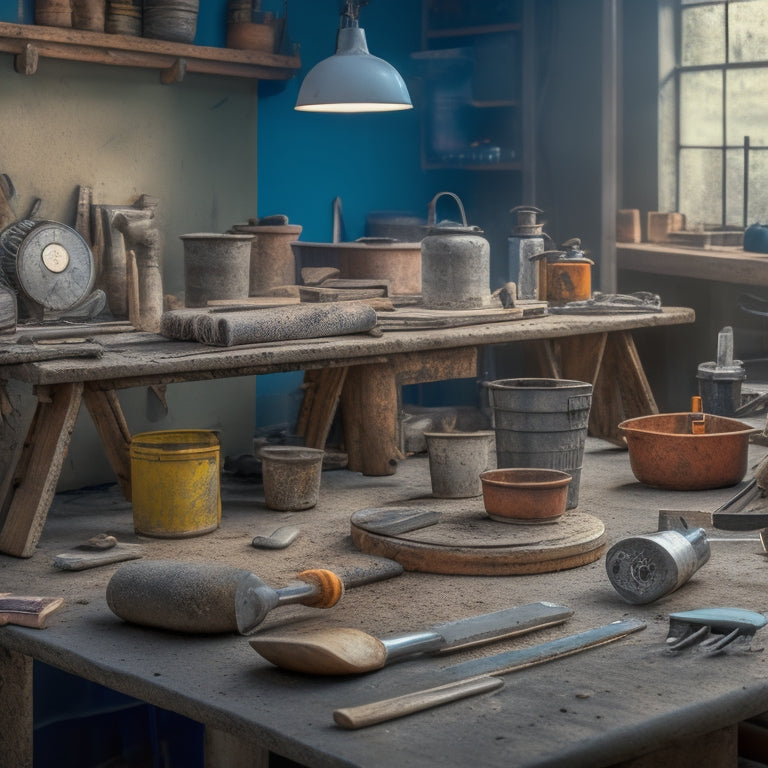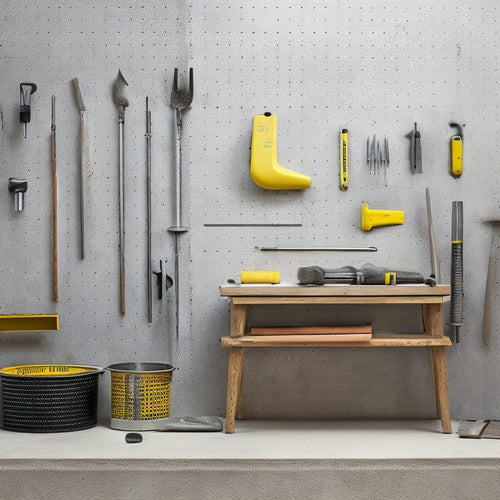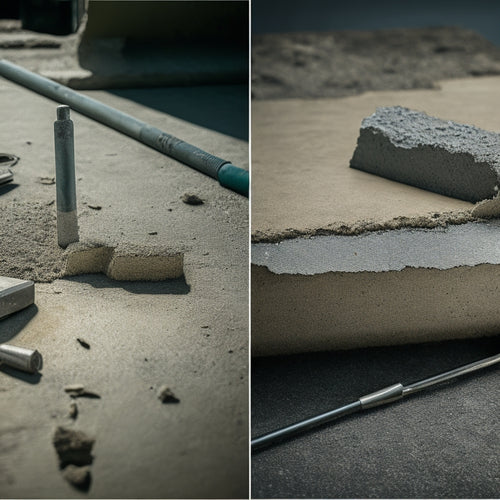
7 Tips for Choosing the Right Concrete Tools
Share
When choosing the right concrete tools, you'll want to evaluate durability factors like material quality, usage frequency, and maintenance requirements. Next, research the manufacturer's reputation online, checking for transparency, customer reviews, and customer service. Compare warranty coverage options, taking into account period length, repair options, and exclusions. Assess the tool's ergonomic design, looking for comfortable grip options, tool balance, and reduced fatigue features. Don't forget to research user reviews and ratings, and reflect on tool maintenance costs, including ongoing expenses and total cost of ownership. By following these tips, you'll be well on your way to selecting the right concrete tools for your projects, and uncovering even more key factors to reflect on.
Key Takeaways
- Evaluate tool durability by considering factors like material quality, usage frequency, and maintenance requirements to ensure long-lasting performance.
- Research the manufacturer's reputation by reading customer reviews, checking website transparency, and assessing their customer service availability.
- Look for warranty coverage options that provide a longer coverage period, repair options, and minimal exclusions for peace of mind.
- Opt for tools with ergonomic design features like comfortable grips, proper weight distribution, and reduced fatigue features to enhance user comfort and productivity.
- Read user reviews and ratings to gain insights into tool performance, common issues, and long-term satisfaction to make an informed purchasing decision.
Evaluate Tool Durability Factors
When tackling a concrete project, your tools are your most trusted allies, and their durability can make all the difference between success and failure. To guarantee your tools can withstand the demands of your project, you need to evaluate their durability factors.
First, consider the tool material. Are they made from high-quality, heavy-duty materials that can resist wear and tear? Or are they flimsy and prone to breaking? Look for tools with durable materials like stainless steel, high-carbon steel, or heavy-duty fiberglass.
Another vital factor is usage frequency. How often will you be using the tool? If you'll be using it daily, you'll need a tool that can withstand heavy use. In this case, look for tools with reinforced handles, heavy-duty motors, or durable blades.
Additionally, consider the tool's maintenance requirements. Can it be easily cleaned and serviced, or does it require specialized care? A tool that's easy to maintain will last longer and perform better over time.
Check Manufacturer Reputation Online
You've evaluated the durability factors of your concrete tools, but that's only half the battle.
Now, it's time to dig deeper and assess the manufacturer's reputation online. This step is essential in ensuring you're investing in a high-quality product from a reliable brand.
Start by researching the manufacturer's website, paying attention to their transparency and willingness to provide detailed product information.
Look for customer reviews, testimonials, and ratings to get a sense of the manufacturer's customer support.
Check if they've a dedicated customer service team, FAQs, and troubleshooting guides. A reputable manufacturer will be open about their products and committed to helping customers resolve any issues.
You can also check third-party review sites, social media, and online forums to get a more thorough view of the manufacturer's reputation.
Compare Warranty Coverage Options
When comparing warranty coverage options, you'll want to examine the length of coverage periods, considering how long you'll be protected against defects or malfunctions.
You should also look into the tool repair options offered, such as whether the manufacturer will repair or replace your tool, and if there are any associated costs.
Coverage Period Length
Concrete tools are only as reliable as the warranty that backs them, and the coverage period length is a critical aspect to assess. When comparing warranty coverage options, you need to take into account the length of time the manufacturer stands behind their product. A longer coverage period typically indicates higher material quality and a more reliable tool.
Look for warranties that offer coverage for at least a year, but ideally two to five years or more. Be certain to check the specific terms of the warranty, as some may have limitations or exclusions that reduce the actual coverage period. A longer coverage period provides you with peace of mind and protection against defects or malfunctions.
It's important to weigh the coverage period against other factors, such as the tool's price and features, to make sure you're getting the best value for your investment. By carefully evaluating the coverage period length, you can make an informed decision and choose a concrete tool that will meet your needs and last longer.
Tool Repair Options
The manufacturer's repair options can greatly impact the overall value of a concrete tool's warranty. When evaluating tool repair options, you'll want to take into account the manufacturer's approach to fixing or replacing broken or worn-out parts.
Look for manufacturers that offer a range of repair techniques, from on-site repairs to mail-in services, to guarantee you can get your tool back in working order quickly.
Additionally, check if the manufacturer provides easy access to replacement parts. Can you purchase them online or through a local dealer? Are they readily available, or do you have to wait weeks for shipping?
A manufacturer with a thorough parts inventory and streamlined ordering process can save you time and hassle in the long run.
You should also compare the warranty's repair process, including the process for submitting claims, the average turnaround time, and any associated fees.
Assess Tool Ergonomic Design
When evaluating tool ergonomic design, you'll want to look for comfortable grip options that fit your hand well, reducing strain and discomfort during extended use.
You should also consider tool balance, as a well-balanced tool will reduce fatigue and improve control.
Additionally, look for features that incorporate reduced fatigue design, such as cushioned grips or adjustable handles, to minimize exhaustion and maximize productivity.
Comfortable Grip Options
Selecting tools with comfortable grip options is vital, as it directly impacts your productivity and overall well-being on the job site. You'll be holding these tools for extended periods, so it's important to choose ones that fit comfortably in your hand.
Look for tools with ergonomic handle materials that provide a secure grip, even with sweaty or gloved hands. Some tools feature rubberized grips, while others have textured surfaces to prevent slipping. Consider the grip textures and materials that work best for you.
When evaluating grip comfort, think about the tasks you'll be performing. If you'll be using the tool for heavy-duty applications, a thicker, more cushioned grip may be necessary. For precision work, a slimmer grip with a firmer texture might be more suitable.
Additionally, consider the size and shape of the tool's handle. A contoured handle that fits naturally in your hand can reduce fatigue and discomfort.
Tool Balance Matters
Tool Balance Matters
Beyond grip comfort, you'll want to assess the overall ergonomic design of your concrete tools, particularly in relation to balance. A well-balanced tool can make a significant difference in your work efficiency and overall experience.
When evaluating tool balance, consider the following factors:
-
Tool weight distribution: Verify the weight is evenly distributed throughout the tool, avoiding any unevenness that could cause strain or discomfort.
-
Tool size and shape: A tool that's too large or too small for your hand can affect balance and control. Look for tools that fit comfortably in your hand and allow for smooth movement.
-
Center of gravity: The center of gravity should be close to your grip, allowing for easy maneuverability and minimizing fatigue.
Reduced Fatigue Design
Into the ergonomic design of your concrete tools, look for features that prioritize your comfort and endurance. A well-designed tool can greatly reduce fatigue, allowing you to work longer and more efficiently.
When evaluating a tool's ergonomic design, look for vibration reduction features, such as anti-vibration handles or shock-absorbing materials. These features can greatly reduce the strain on your hands and arms, minimizing the risk of injury and fatigue.
Additionally, consider tools made with lightweight materials. These tools are often designed to be more balanced and easier to maneuver, reducing the physical strain on your body.
Lightweight materials can also reduce the overall weight of the tool, making it easier to handle and transport. By choosing tools with ergonomic designs that prioritize comfort and endurance, you can reduce fatigue and improve your overall productivity on the job site.
Research User Reviews and Ratings
When narrowing down your options for concrete tools, you'll want to dig into user reviews and ratings to get a sense of how well a product performs in real-world scenarios.
This is where customer feedback comes in, providing useful revelations into the product's strengths and weaknesses. By reading reviews, you'll get a better understanding of how a tool handles concrete, its durability, and any potential issues that may arise.
Here are some key things to look for in user reviews:
-
Product performance: Pay attention to how well the tool performs its intended function. Do users report smooth, consistent results, or do they struggle with jamming or clogging?
-
Ease of use: Look for feedback on how easy the tool is to operate, especially for novice users. Are the controls intuitive, or do users find them confusing?
-
Durability and maintenance: Check if users report any issues with the tool's build quality or maintenance requirements. Are there any common problems that arise, and how easy are they to fix?
Consider Tool Maintenance Costs
Beyond the initial purchase price of a concrete tool, you'll need to factor in the ongoing costs of maintenance and upkeep. These costs can add up quickly, so it's crucial to take them into account when choosing the right tool for your project.
Create a maintenance schedule to guarantee regular checks and servicing, which will help prevent unexpected downtime and costly repairs.
Conduct a cost analysis to determine the total cost of ownership, including the initial purchase price, maintenance costs, and replacement parts. This will give you a clear representation of the tool's overall expense and help you make an informed decision.
Additionally, take into account the tool's durability and expected lifespan, as well as the availability and cost of replacement parts. By factoring in these maintenance costs, you can ensure that your chosen tool fits within your budget and meets your project's needs.
Verify Certification and Compliance
The concrete tool you choose must meet industry standards and regulations to guarantee safety and quality. You can't afford to compromise on safety standards, as it may put your team and project at risk.
When verifying certification and compliance, you need to confirm the tool meets the required safety standards and industry regulations.
Here are three key considerations to keep in mind:
-
Look for certifications: Check if the tool has certifications from reputable organizations, such as OSHA or ISO. These certifications confirm the tool meets specific safety and quality standards.
-
Check industry regulations: Familiarize yourself with industry regulations, such as those set by the American Society for Testing and Materials (ASTM) or the International Organization for Standardization (ISO). Confirm the tool complies with these regulations.
-
Verify manufacturer claims: Don't take the manufacturer's word for it. Verify their claims by checking for third-party testing and validation. This confirms the tool has been tested and meets the required safety and quality standards.
Frequently Asked Questions
Can I Use Concrete Tools for Other Masonry Materials Like Brick or Stone?
You can use concrete tools for other masonry materials like brick or stone, but it's essential to check the tool's masonry tool compatibility and intended use to guarantee safe, effective multi-material usage without damaging the tool or material.
Are Expensive Concrete Tools Always of Higher Quality?
You're wondering if pricey concrete tools always guarantee superior quality; while it's true that brand reputation and tool durability often justify higher prices, you shouldn't assume that's always the case, as some brands may overcharge without providing exceptional performance.
Can I Share or Borrow Concrete Tools With Other Workers?
As you ponder sharing or borrowing concrete tools with coworkers, remember that tool sharing can be convenient, but it may compromise equipment maintenance, putting your project's quality and timeline at risk - weigh the pros and cons carefully.
Do Concrete Tools Require Special Storage or Handling?
You'll need to prioritize tool maintenance and guarantee proper storage conditions to extend the life of your concrete tools, which means keeping them clean, dry, and organized in a designated area, away from harsh weather and corrosive substances.
Are There Any Specific Safety Precautions for Using Concrete Tools?
As you plunge into the concrete jungle, remember safety is your lifeline; you'll need personal protective gear like gloves, goggles, and a dust mask, and prioritize equipment maintenance to avoid tool failures that can lead to accidents.
Conclusion
So, you've made it through the concrete jungle of tool selection - congratulations! Now, don't be a rookie and think you can just wing it with any old tools. Remember, your tools are only as good as the job they help you do. Follow these 7 tips and you'll be well on your way to becoming a concrete expert. And if you don't, well, you might as well be trying to build a skyscraper with Lego blocks.
Related Posts
-

10 Must-Have Tools for Concrete Repair Organization
You'll need a solid organization system to keep your concrete repair tools and materials within easy reach, protected...
-

Essential Tools for Epoxy Concrete Floor Repair
You'll need a thorough arsenal of specialized tools to guarantee a successful epoxy concrete floor repair. Floor prep...
-

Top Tools for Concrete Adhesion Success
When it comes to concrete adhesion success, you'll need to wield the right tools and techniques to guarantee a strong...


